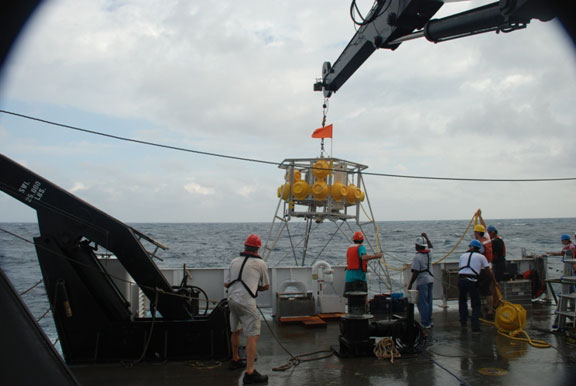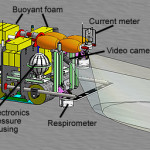
One of the problems we face as deep-sea biologists is our limited understanding of the 4th dimension – temporal variability. We don’t know much about how often things change from what we see when we explore. For instance, if you only went to NYC on Thanksgiving, you’d think there was always a parade. Its like that in the deep. We send a robot to 500m, but the chances we’ll be back next month or next year are pretty slim. So, we don’t always know how a site changes.
One way to overcome the problem is to deploy a benthic lander for an extended duration, equipped with cameras and instruments. This is what’s happening in the picture from the DISCOVRE Expedition in the Gulf of Mexico. Dr. Steve Ross and colleagues are working to deploy the BOBO lander near the Mississippi Canyon. Craig wrote about Ruhl and Smith’s work last week. Here, Steve talks about the BOBO lander and international cooperation, and he answers the age-old question "How many Europeans does it take to build a lander?" –PJE
———
by Steve W. Ross (22 Oct 2008, at sea eastern Gulf of Mexico)
One of the most exciting developments in our deep-sea research occurred when colleagues from Holland and Scotland decided to join us. For years we have been conducting similar types of research on deep-sea coral habitats, but on different sides of the Atlantic. Drs. Tjeerd van Weering, Gerard Duineveld, and Furu Mienis of the Royal Netherlands Inst. for Sea Research (NIOZ) and Drs. J. Murray Roberts and Andrew Davies of the Scottish Association for Marine Science (SAMS) are now working with us closely and bringing unique tools and experience to this topic.
For the current cruises, these Europeans shipped to the US two large, highly technical benthic landers. These are a common tool for their research projects and using these, we will produce the first long term, highly intense data for deep-sea coral mounds. The landers include instruments for measuring bottom currents, sediment/particle “rain”, temperature, turbidity, and one lander has a pan/tilt video camera, while the other has a digital still camera. The cameras are programmed to take views at regular intervals. In addition, colleagues from Univ. of South Florida (Dr. David Mann) and Univ. of NC at Chapel Hill (Dr. Harvey Seim) have contributed underwater listening devices and up-looking current meters, respectively. We also attached settling plate experiments to the landers.
We deployed both landers early in our cruise for a test run. During one of our ROV dives we were able to find and film the BOBO lander. After about four days we brought them up (by releasing weights from an acoustic trigger) and quickly downloaded data, reprogrammed instruments, and recharged batteries. Then both landers were again sent to the bottom where they will stay for about one year. We will return next September to retrieve them. They will be cleaned, refurbished and then put down for another year in the Atlantic, probably off North Carolina. The massive amount of data we expect from these instruments will complement many research topics.

How many Europeans does it take to build a lander? Four, plus one American. The lander crew scrambles to assemble the ALBEX lander before it is trucked to the R/V Nancy Foster.






Such cool stuff. I am so jealous. I am also curious – why do you have these set up as “drag and drop” instrument packages – you deploy, leave on the bottom, and retrieve to download. Why not a buoy with a satellite transmitter that the lander can deploy and real back in from time to time? Four days is great, but four years would be so much better!
In response to this comment/question, this is currently the most efficient and cost effective way to deploy the landers in deep-sea depths. A bouy & satellite system would quickly make the system too expensive and prone to failures. We will be working on some different ways to get the data back sooner. While 4 years would be nice, few (if any) instruments can record accurately for that long because of issues with biofouling, battery life, and calibrations.
Yeah, I’m trying to picture a 500 m rope and buoy system that wouldn’t somehow lift the lander off the bottom in a big swell. Excellent question, Philip. Your response is direct from the RV Nancy Foster! Thanks for the quick response, Steve. Good luck to the Expedition.
Phillip,
Your idea is actually being done here at MBARI in just about the same way you propose. In the second link you can see how the engineers here dealt with the problem Peter raises by putting a flexible S bend in the cable.
http://www.mbari.org/moos/mooring/mooring.htm
and
http://www.mbari.org/news/homepage/2004/moosII.html